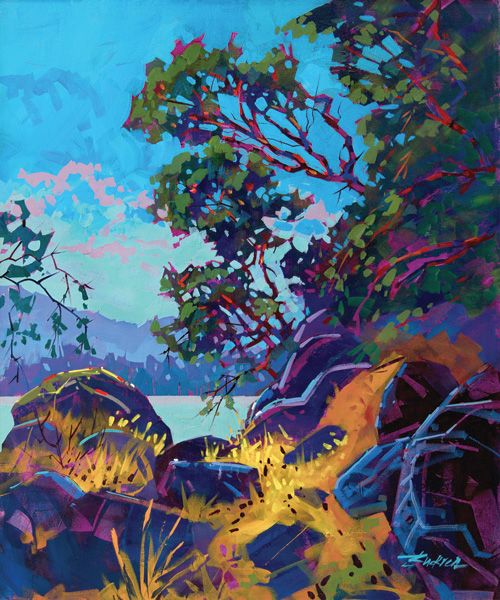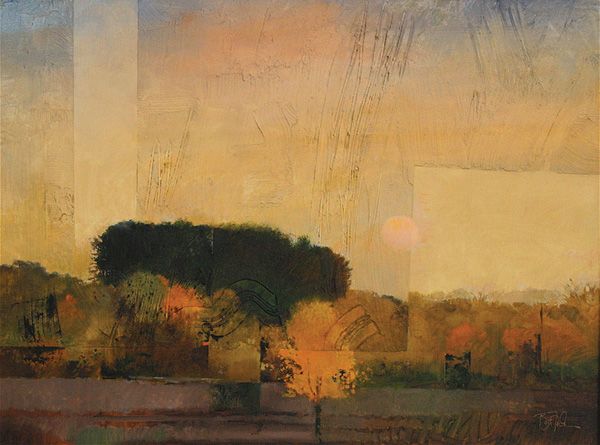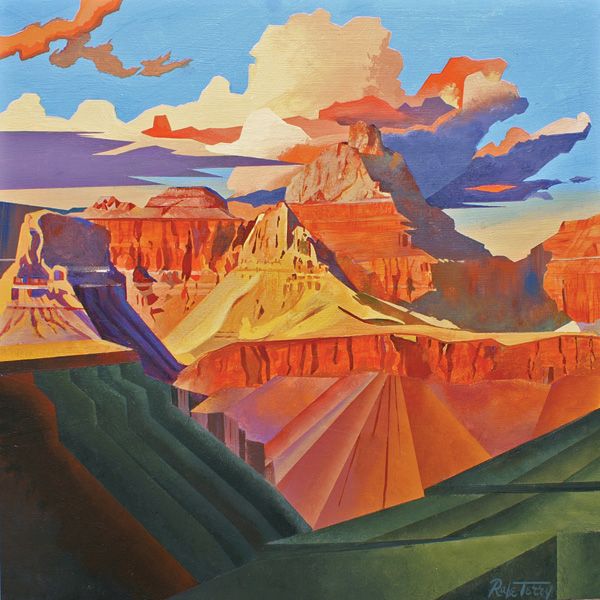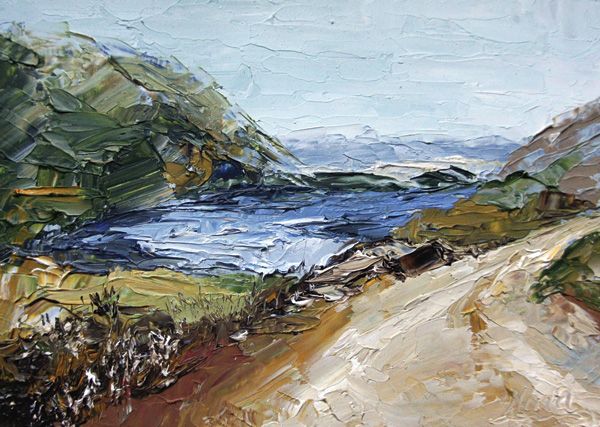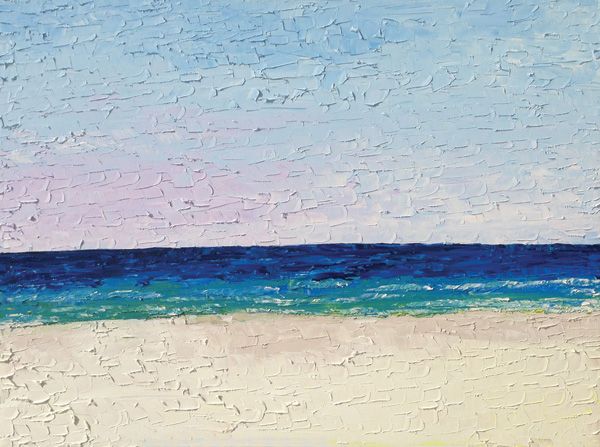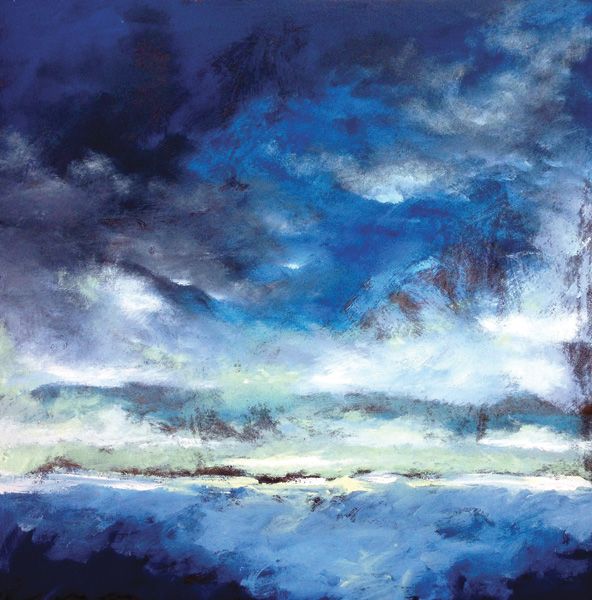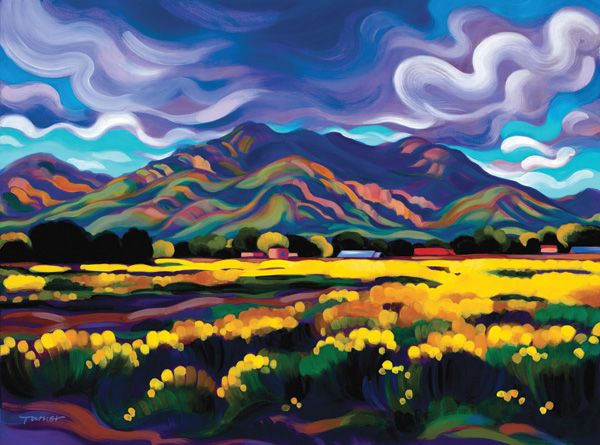Meet 8 artists who create contemporary visions of the West
Brian Buckrell
Bart Forbes
Rafe Terry
Nina Fabunmi
Tim Kenney
Robert S. Brown
Jill Holland
Tracy Turner
Brian Buckrell
Canadian artist Brian Buckrell creates intensely colored landscapes that are inspired by his muse, travel. They begin with a landscape composition that attracts him, which might be mountains, a shoreline, or a rural scene. He starts each piece by drawing with pencil and acrylic markers, on top of which he then builds multiple layers of transparent and opaque acrylics until the painting feels finished.
Buckrell came to the art world relatively late in life. After being “dragged to a drawing class” on his 60th birthday, he says, he found that painting suited his solitary nature. In the nine years following that class, he’s attended over 40 art workshops, investing himself in his artwork with the same tenacity he once devoted to his pre-retirement career. “I was a professor of veterinary reproductive technologies and ran three different vet practices over the years,” Buckrell explains. “Painting is the hardest thing I have ever done, but that is what makes it fun.”
Today he paints primarily in acrylics and is moving away from the tight, representational work in which he was initially trained. “As my eye matured, I have moved toward strong brush strokes, strong colors, and colorful interpretation,” he says. “I don’t want it to be boring.” Buckrell is represented by Avens Gallery, Canmore, AB; White Dog Whistler Studio Gallery, Whistler, BC; Village Gallery, Sidney, BC; Englishman River Art Gallery, Parksville, BC; Mark Penney Gallery, Ucluelet, BC; Whyte’s Framing and Gallery, Comox, BC; and Jason Alexander Gallery, Collingwood, ON, all in Canada. —Laura Rintala
Bart Forbes
Where we are isn’t always where we’ve been. The pursuit of change challenges us to grow, and in that evolution, we learn about who we are and where we want to go. Nearly 10 years ago, Bart Forbes experienced this epiphany. For years Forbes had a storied career as an illustrator. He worked for such publications as Time and Sports Illustrated, produced many classic paintings for PGA golf tournaments, and was selected as the official artist of the 1988 Summer Olympics.
After nearly 40 years as an illustrator, though, Forbes craved change. “I wanted to be a painter, but illustration seemed a [better] way of earning a living over studio painting,” Forbes remembers. “I needed to move away from a career where I was painting for the specific needs of an agency or a magazine. I wanted to do things that were purely my concept and my original thought.”
His illustration career now behind him, he has had the opportunity to take the next step in his journey. Forbes’ loose yet focused style is expressive and dynamic and is the result of a lifetime of drawing and observing. “I’m not your typical landscape painter. My paintings rarely depict a particular place but rather an interpretation of nature,” he says. “I would say my work is like jazz. Jazz is very improvisational, and my work is the same. I think the fun is forcing myself to go places in my paintings where I’ve not been before.” Forbes is represented by Valley House Gallery, Dallas, TX, and Telluride Gallery, Telluride, CO. —Joe Kovack
Rafe Terry
Rafe Terry has long loved the landscape of the Southwest. Prior to embarking on his art career, the Massachusetts-born artist spent time in the Air Force and was stationed in Alaska and then in Alamogordo, NM. “I had never been to the Southwest before then,” he says, “and I loved everything about it.”
After finishing his military service, Terry returned to Massachusetts and completed his schooling at the Art Institute of Boston. “Somehow,” he says, “40 years slipped by,” while he worked in a Boston ad agency and, in his spare time, painted traditional representational landscapes of the Northeast. In 1995, Terry and his wife moved to Arizona, and his painting changed as dramatically as did his environment. Influenced by the cubist and expressionistic works of Lyonel Feininger and inspired by the Southwest’s “enormity and changing colors,” Terry’s landscapes became hard-edged, highly stylized, and charged with bold, saturated color. “I love to paint rich reds, oranges, and sienna, with their complements of blues and purples playing the minor role. Or I’ll compose the reverse palette emphasizing the quiet blues and violets found in shadows or evening light with accents, then, in warm tones.”
Terry is particularly drawn to paint the red-rock landscapes of Sedona, the majesty of the Grand Canyon and the Colorado River, the sandstone buttes of Monument Valley, and the towering monoliths of Zion National Park. He is represented by Goldenstein Gallery, Sedona, AZ; Van Gogh’s Ear, Prescott, AZ; and Alderwood Fine Art, Salt Lake City, UT. —Laura Rintala
Nina Fabunmi
Growing up in Nigeria, Nina Fabunmi says she lived a sheltered life. Her father was protective of his children, but as an architect, he encouraged art and creativity. As she grew, Fabunmi wrote poems, made collages, and painted in watercolors, but as a practical measure, she earned a degree in estate management. After a brief stint in real estate, Fabunmi worked in various other fields before a big break afforded her the chance to join the art world.
In 2011, the security advisor of Nigeria, an art lover and collector, commissioned Fabunmi to paint works for his guesthouse. Apprehensive, she painted 21 pieces in two months. The money from her commission helped her to get a visa and to travel to the United States to attend the Academy of Art University in San Francisco. There her landscape paintings began to take shape, and her impressionistic, loose style emerged. “Nigeria’s landscape hadn’t inspired me to paint it,” Fabunmi admits. “But I was inspired by San Francisco because it has this unique terrain. I’ve never seen it anywhere before.”
Today, Fabunmi paints exclusively in oils and has developed her own artistic imprint by imbuing her works with Nigerian culture. “I wanted something that represented where I am from. I’m from Africa, and we love colors, so my paintings are vibrant and colorful,” Fabunmi says. “We have this thing called tribal marks.” So she incorporates a lot of scratching and mark-making to build up her forms. “That’s my way of saying, I am from Nigeria, and I’m trying to put my culture into my paintings,” she says. Fabunmi is represented by Joyce Gordon Gallery, Oakland, CA, and Gallery Guichard, Chicago, IL. —Joe Kovack
Tim Kenney
Tim Kenney is a man on a mission. As this story was going to press, Kenney was crisscrossing the country on an intensive, tour de force painting expedition. On May 14, the landscape painter set out from his home in Norman, OK, on a road trip with a goal of creating 50 paintings in 50 states in 50 days. We caught up with him in Vermont, at which point he had already sold 14 paintings. “I just sold Rhode Island,” he said. From the sale of these on-the-road works, the artist is donating 20 percent of the proceeds to the Nicole Jarvis MD Parkinson’s Research Foundation.
In his former life, Kenney worked as a contractor. But during visits to Santa Fe several years ago, he saw landscape paintings by artist Pat Matthews. When he returned home, Kenney says, he couldn’t stop thinking about the paintings and, ultimately, decided he wanted to pursue fine art professionally. In 2008
Kenney began taking classes with artist Carol Armstrong, and the rest is history.
Up until this recent trip, Kenney often turn-ed to the picturesque terrain of Colorado and New Mexico for inspiration—places where he also spent his teenage summers hiking, camping, and fly-fishing. In terms of style, Kenney is a self-described “impressionist and colorist.” His landscapes demonstrate his affection for a vibrant palette of colors. Whether he is capturing Maine’s rocky coast or California’s arid desert, Kenney’s goal is to convey “the feeling of being there and the feeling of happiness” to
his viewers. He is represented by Beals & Co., Santa Fe, NM, and Mountain Traditions, Steamboat Springs, CO. —Bonnie Gangelhoff
Robert S. Brown
For painter Robert S. Brown, the western landscape inspires awe, respect, and creativity in ways that no other subject can. “Everywhere I look in the West, I see patterns, colors, and lighting effects that make me feel the urgent need to express it in paint on canvas,” Brown says. He grew up in Nebraska and Iowa and became fascinated with drawing and painting at a young age. In those days, it was the architecture of buildings—as opposed to landforms—that inspired him, leading to a 32-year award-winning career in architectural design. But as Brown approached retirement, his “inner spiritual voice” told him to return to painting, so he spent the next 10 years doing just that.
In 2011, Brown retired and moved to Santa Fe, NM—a decision that had a tremendous influence on his art. “My past work was all in acrylic paint applied with brushes in a more academic, representational style,” he says. “Moving to Santa Fe and painting full time changed everything, and my most recent work is very different: all done with palette knife in oils in a looser, more painterly style.” The artistic freedom and natural beauty Brown found in New Mexico continues to inspire his bold, contemporary interpretations of the western landscape. “It’s my experience of joy and awe before these dramatic, rugged landscapes and architectural landforms that inspires me to try to portray my feelings about these marvelous creations,” he says. Brown is represented by Mirada Fine Art Gallery, Denver, CO; K. Newby Gallery, Tubac, AZ; and Worrell Gallery, Santa Fe, NM. —Lindsay Mitchell
Jill Holland
Jill Holland’s abstract landscapes come from deep inside and connect her to something beyond herself. Inspired by scripture, nature, and travel, Holland channels the deep connectivity she feels with life into conceptual representations of the beauty of the world. “It really speaks to the root and the core of why I do what I do,” Holland says. “Scripture says ‘the deep call unto deep.’ I so relate to that because there really is something deep inside me that just cries out and longs for the deep things of the Lord. And I find that connection so many times in landscapes.”
Her landscapes are not typical depictions of picturesque scenes. Using a variety of media—everything from oils and acrylics to sand, plaster, spray paint, wood stain, and craft paints—Holland creates works that challenge the viewer to find their own interpretation in the scene as opposed to painting a photorealistic re-creation of a majestic mountain or coastline. “It’s taken me quite a while to settle into this style of abstract landscapes,” Holland says. “My favorite thing is that I can create a landscape and leave it open to the imagination, because everyone who looks at it is going to have a different interpretation of what it is. There’s so much about art that’s a connection, and if someone connects to a work, that’s the ultimate goal.” Holland is represented by Fredericksburg Art Gallery, Fredericksburg, TX; Jack Meier Gallery, Houston, TX; and Skyline Art Services, Houston, TX. —Joe Kovack
Tracy Turner
For New Mexico landscape painter Tracy Turner, the natural world embodies more than what the eye perceives. Whether she’s painting riotous New Mexico cottonwoods aflame in autumn color or the orderly rows of a French lavender field, the underlying spirit or meaning of the scene is what Turner strives to capture and convey through her use of color. An admirer of the colorists, surrealists, and Fauvists, she plays with color relationships to create vibrancy and deep saturation. “I was lucky to have great color-theory teachers,” she says. “I work colors against each other to get the maximum saturation.” She begins with a vivid underpainting and then, working in layers, puts down color and sets it with glazing. “Until I feel that depth of color, I’m not satisfied,” she says, noting that all of her paintings have at least five layers of color.
Describing her work as magical realism, she says, “Even though I paint outdoors to start, that is really just the tip of the iceberg. I’m always looking for the magical essence of the landscape.” Her paintings derive from a combination of studying nature and “making things up,” she says—seeing something that is there and also uncovering something beneath the surface.
Turner says, “The people who love my work say that it is healing for them. It’s the highest compliment to know that there’s something from my heart that gets translated through color and form, that I couldn’t convey through words, and that gives them peace. It’s that transmission of beauty that we very much need more of because life can be very challenging.” Turner is represented by The Ranch at Taos, Taos, NM. —Laura Rintala






